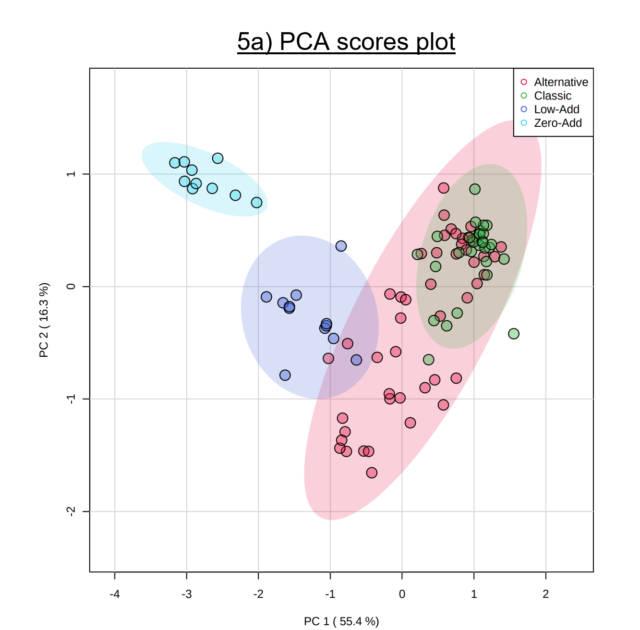What are biogenic amines and why can they be a problem?
By Deborah Parker Wong
Most informed wine consumers have accepted the fact that sulfur isn’t the root cause of wine headaches, but the misconception that sulfur dioxide (SO2) causes adverse reactions to wine consumption is still often perpetuated by the media and can persist among casual consumers. Instead, what’s been identified as a source of adverse reactions to no- and low-sulfur red wines, particularly by histamine-sensitive consumers, are biogenic amines (BA).
The Basics
Biogenic amines in wine are a byproduct of fermentation and malolactic conversion. They’re organic compounds produced by yeasts and lactic acid bacteria during a process that reduces the carboxyl group in amino acids and raises the pH, creating a more hospitable environment for the growth and survival of the lactic acid bacteria.
As a result, several different amines are produced, with tyramine and histamine being the most frequent and problematic. Together, they can cause a synergistic reaction known as “biogenic amine toxicity,” which is characterized by headaches, migraine, nausea, vomiting and hypertension. Sulfite reactions, on the other hand, are almost exclusively limited to respiratory symptoms affecting sufferers of acute asthma.

Curiously, some no- and low-sulfur wines contain elevated BA levels, while others contain none. In cellars where biogenic amine levels are high, a combination of higher pH musts, native ferments, and no- or low-sulfur additions at the end of malolactic conversion are the key contributing factors. The resulting wines let lactic acid bacteria remain metabolically active, which leads to increasing amounts of amines produced during aging.
To prevent BA from forming, winemakers can inoculate for malolactic conversion, ensure pH levels remain low, and use SO2 to keep microbial load to a minimum.
The Study
In a paper titled “What Is the Relationship Between the Use of Sulphur Dioxide and Biogenic Amine Levels in Wine?,” Sophie Parker-Thomson, MW, notes that the effects of biogenic amines in wine are heightened due to ethanol and acetaldehyde, compounds that occur naturally in wine and inhibit our body’s ability to detoxify those effects, making a compelling argument for establishing a low-BA category of wine.

Her study of 100 New Zealand Sauvignon Blancs included a cross-section of wine styles and sulfur dioxide regimes: classic, alternative, low- and zero-SO2 wines. Analysis for three biogenic amines — histamine, tyramine and putrescine — revealed very high biogenic amine concentrations in zero- and low-SO2 wines, while the lowest concentrations were recorded in the classic wine style with total SO2 additions of greater than 65 to 80 mg/L.
From a sensory perspective, the most prolific biogenic amine-producing bacteria are also the cause of wine faults, including mousiness (which some consumers are not genetically able to detect) and ropiness. According to Parker-Thomson, “It is beyond coincidence that symptoms of biogenic amine toxicity mirror the anecdotal evidence for adverse reactions from wine consumption.”
The Testing
In winemaking, there are three key prerequisites for increased levels of BA production: availability of free amino acids or proteins, microbes with decarboxylase genes, and conditions that favor microbial growth.
Casey Graybehl, R&D winemaker and production director for Obsidian Wine Co. in Sonoma, Calif., makes three excellent quality, low-sulfur wines for the company’s Rabbit Hole label: Máslás, a piquette; Pezsgö, petillant naturel; and Pear Blanc, a sparkling grape and pear wine. Graybehl was curious about amine production and had the 2021 vintages tested.
“Our winemaking practices for the Rabbit Hole wines, which are typically bottled immediately after harvest, include native yeasts, low pH musts with only a small amount of sulfur added pre-bottling to inhibit malolactic fermentation, and zero filtration or fining. While this would seem like a scenario for biogenic amines to be produced, upon testing we didn’t see increased levels over our more standard winemaking practices. It’s very likely that our low pH musts are inhibiting amine production.”

If BA levels are high in a wine, it can be treated with a highly acidic, silica-based additive to remove biogenic amines. Impacts of treatment can include an initial decrease in ethyl esters (that recovered after several days), and a perceptible impact on wine color (probably due to a slight decrease in the pH of treated wines). The proposed technique would be better suited to wines aged in barrels than for young wines.
The Reality
Enjoyed alone, wines with normal levels of biogenic amines aren’t likely to trigger a reaction. But sensitive consumers who unwittingly pair wines that have elevated BA levels with foods (including aged cheese and charcuterie) that are rich in amines are at far greater risk for adverse reactions; alcohol and some medications, including statins, also increase BA’s toxic effect. Studies have shown that a mere 10 mg of tyramine can trigger the onset of migraine and, in foods with different levels of histamine, symptoms of biogenic amine toxicity occurred “at levels between 75 mg to 300 mg” in both histamine-intolerant and healthy consumers.
Because consumption of biogenic amines can pose a threat to human health, the Food and Drug Administration has set a legal limit of 50 ppm (5 mg/100 g) of histamine in seafood products, but no specific regulations exist for biogenic amines in other food stuffs — or for histamines in wine.
The results of Parker-Thomson’s study demonstrate that sulfur is an important, if not the most important, factor in avoiding toxic biogenic amine levels in wine, which is in direct conflict with the current trends in no- or low-sulfur dioxide wines. She concludes, “If SO2 additions are unconscionable for the Natural Wine movement, perhaps zero-added SO2 wines should carry a mandatory high-BA warning — unless they can prove otherwise.”
_______________________________________________________
 Deborah Parker Wong
Deborah Parker Wong
Deborah Parker Wong, DipWSET, was appointed national editor, USA for the Slow Food Slow Wine Guide in 2020. As global wine editor for sister publications the SOMM Journal and The Tasting Panel magazines, she has been writing about the beverage alcohol industry for these and other outlets since 2004. She teaches as an adjunct professor in the Wine Studies departments at Santa Rosa Junior College and Cabrillo College and owns a Wine & Spirit Education Trust school offering Level 2 and Level 3 certifications. In addition to writing and speaking about wine, she is currently pursuing a Master’s Degree in Viticulture and Enology at California State University, Fresno. www.deborahparkerwong.com



















Truly excellent article.
Fascinating!
Part of why we keep our Ph down.
Let’s push to allow it in the label. I list all ingredients and pesticides used now.
Paul Vandenberg
Paradisos del Sol Winery and Organic Vineyard m
Well written! Really clear explanation with the science, but very accessible. I enjoyed and will share! Thanks.